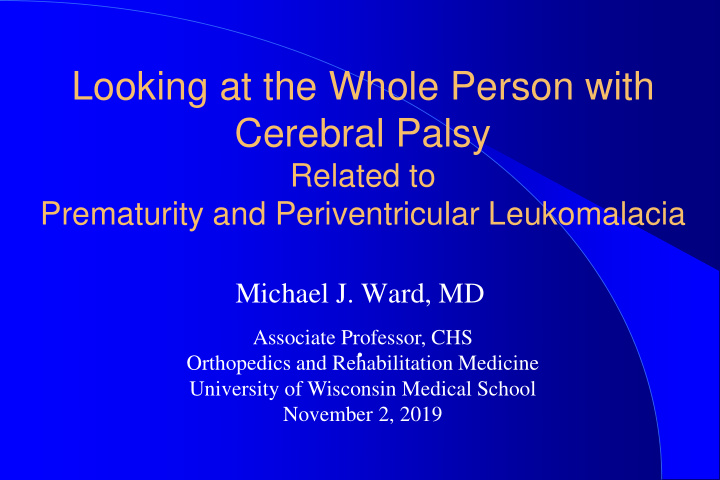



Looking at the Whole Person with Cerebral Palsy Related to Prematurity and Periventricular Leukomalacia Michael J. Ward, MD Associate Professor, CHS . Orthopedics and Rehabilitation Medicine University of Wisconsin Medical School November 2, 2019
OBJECTIVES 1. Understand the relationship of prematurity, MRI findings of periventricular leukomalacia, and the diagnosis of cerebral palsy. 2. Discuss how the white matter supports critical interconnection in the brain tissues 3. Review motor, sensory and cognitive function challenged by periventricular leukomalacia.
WHAT IS CEREBRAL PALSY? .
Modern consensus definition: – Group of disorders of movement and posture – Non-progressive etiology – Damage to the fetal or infant brain – Often accompanied by co-occurring problems with sensation, perception, communication, and/or behavior and/or seizure disorder Bax 2005 DMCN
Periventricular leukomalacia (PVL) Cerebral palsy is caused by some abnormality in the brain. PVL is the largest single etiology of cerebral palsy. PVL is caused by a complex series of events in the brain set in motion after birth among newborns with prematurity and very low birth weight.
Periventricular leukomalacia (PVL) Cerebral ventricles: Interconnected system of spaces that continue and circulate the cerebrospinal fluid
Periventricular leukomalacia (PVL) Periventricular leukomalacia is Peri = around Ventricular = deep brain fluid spaces Leuko = white matter Malacia = thinning Thinning of the white matter surrounding the ventricles
DIAGNOSIS: MRI with Periventricular leukomalacia Normal brain PVL
Cerebral Palsy: Cranial imaging findings PVL Gray matter Basal ganglia Malformation Miscellaneous Normal Bax JAMA 2006
Motor impairments with CP are related to the cortical anatomy Precentral gyrus and motor homunculus
Cortical anatomy combine with connectivity .
IMAGES OF CONNECTIVITY: The Connectome .
BRAIN SURFACE: Cortical anatomy If the periventricular leukomalacia (PVL) disrupts connections under the motor area, there would be motor manifestations of cerebral palsy
PVL and spastic diplegic CP Motor homunculus PVL Leg fiber connections are more affected than hand fibers related to more central location
PVL and CP Spastic diplegia most frequent pattern: more leg than arm involvement
PVL and CP More widespread PVL may cause additional hand impairment, or spastic quadriplegia More PVL on one side as compared to the other may cause spastic hemiplegia with same side arm and leg involved
Periventricular leukomalacia PVL is not limited to the region under the motor fibers. If it involves tissue forward of the motor area, this may affect self regulation and attention ADD is also commonly associated with prematurity and/or PVL
Periventricular leukomalacia …and if it involves tissue behind the motor area, this will affect sensory processing MRI scan in children with CP frequently demonstrate abnormalities in the sensory areas
CEREBRAL PALSY Sensory concerns are common – Hearing loss 7-12% – Visual impairment overall 80% – Tactile impairment 50-75% – Visual-perceptual skill development and sensory processing are very frequently different for people with CP.
CORTICAL CONNECTIVITY: Ventral stream: Connects vision to lower temporal lobe to recognize the name of the object
CORTICAL CONNECTIVITY: Dorsal Stream: Connects vision to the sensory area of the arm for eye-hand coordination
CORTICAL CONNECTIVITY: Angular gyrus: Important connection in left brain -Wernicke’s area- sensory speech -Broca’s area- motor speech These are short tracts, using less white matter. PVL has a relatively low impact on verbal abilities.
CORTICAL CONNECTIVITY: Left brain and right brain have differences in the patterns of connectivity. PVL is poses more difficulty on the function of the right hemisphere.
CORTICAL CONNECTIVITY: Functions of the right brain, particularly the specialized functions of processing complex visual and spatial material, are VERY dependent on rich connectivity, particularly the right parietal lobe
Functions of the parietal lobe: RELATIONAL How are my body parts related to each other? How is my body connected to my clothes? Where is my body related to the shape of a seat? Where is my moving body going related to gravity? Where is my body related to what I am seeing? What is my relationship to this group of people? How is my behavior connected to my core values?
Functions of the parietal lobe: RELATIONAL Possible manifestations of loss of parietal connectivity: Sensory integration concerns Clumsiness Social awkwardness Good vocabulary, challenged communication Feeling disorganized and overwhelmed
Functions of the parietal lobe: RELATIONAL These perceptions are essential to function in daily life. They are also hard to understand and measure.
SUMMARY Differential treatment for different areas?
IMAGES OF CONNECTIVITY .
Recommend
More recommend